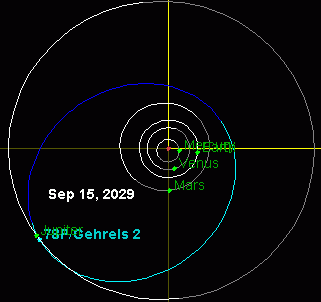78P/Gehrels
 | |
| Discovery | |
|---|---|
| Discovered by | Tom Gehrels |
| Discovery date | September 29, 1973 |
| Designations | |
| 1973 XI; 1981 XVII; 1989 XVII | |
| Orbital characteristics | |
| Epoch | March 6, 2006 |
| Aphelion | 5.462 AU |
| Perihelion | 2.009 AU |
| Semi-major axis | 3.735 AU |
| Eccentricity | 0.4622 |
| Orbital period | 7.22 yr |
| Inclination | 6.2530° |
| Last perihelion | April 2, 2019[1][2] January 12, 2012[3] October 27, 2004[1][4] |
| Next perihelion | 2026-06-25[5] |
78P/Gehrels, also known as Gehrels 2, is a Jupiter-family periodic comet in the Solar System with a current orbital period of 7.22 years.
It was discovered by Tom Gehrels at the Lunar and Planetary Laboratory, Arizona, USA on photographic plates exposed between 29 September and 5 October 1973 at the Palomar Observatory. It had a brightness of apparent magnitude of 15. Brian G. Marsden computed the parabolic and elliptical orbits which suggested an orbital period of 8.76 years, later revising the data to give a perihelion date of 30 November 1963 and orbital period of 7.93 years.[6]
The comet's predicted next appearance in 1981 was observed by W. and A. Cochran at the McDonald Observatory, Texas on 8 June 1981. It was observed again in 1989 and in 1997, when favourable conditions meant that brightness increased to magnitude 12.[6] It has subsequently been observed in 2004 when it reached magnitude 10, 2012, and 2018.[1]
Outward migration[edit]
Comet 78P/Gehrels' aphelion (furthest distance from the Sun) of 5.4AU[3] is in the zone of control of the giant planet Jupiter and the orbit of the comet is frequently perturbed by Jupiter.[7] On September 15, 2029, the comet will pass within 0.018 AU (2.7 million kilometers) of Jupiter[7] and be strongly perturbed. By the year 2200, the comet will have a centaur-like orbit with a perihelion (closest distance to the Sun) near Jupiter.[8] This outward migration from a perihelion of 2AU to a perihelion of ~5AU could cause the comet to go dormant.
| Year (epoch) | 2009[3] | 2030 | 2200[8] |
|---|---|---|---|
| Semi-major axis | 3.73 | 6.02 | 9.37 |
| Perihelion | 2.00 | 4.08 | 4.99 |
| Aphelion | 5.46 | 7.96 | 13.7 |

See also[edit]
References[edit]
- ^ a b c Seiichi Yoshida (2006-10-03). "78P/Gehrels 2". Seiichi Yoshida's Comet Catalog. Retrieved 2010-02-24.
- ^ Syuichi Nakano (2011-06-10). "78P/Gehrels 2 (NK 2102)". OAA Computing and Minor Planet Sections. Retrieved 2012-02-18.
- ^ a b c "JPL Small-Body Database Browser: 78P/Gehrels 2" (2011-05-21 last obs). Retrieved 2009-05-11.
- ^ Syuichi Nakano (2009-04-20). "78P/Gehrels 2 (NK 1760)". OAA Computing and Minor Planet Sections. Retrieved 2010-02-24.
- ^ "78P/Gehrels Orbit". Minor Planet Center. Retrieved 2020-06-29.
- ^ a b Kronk, Gary W. "78P/Gehrels 2". Cometography. Retrieved 25 February 2015.
- ^ a b c "JPL Close-Approach Data: 78P/Gehrels 2" (2006-02-26 last obs). Retrieved 2009-05-11.
- ^ a b Heider. "Orbital Elements of 78P/Gehrels in 2200". Archived from the original on 2015-06-06. Retrieved 2009-05-11.
External links[edit]
- Orbital simulation from JPL (Java) / Horizons Ephemeris
- 78P/Gehrels – Minor Planet Center
- 78P/Gehrels 2 (2012)
- 78P at Kronk's Cometography
- Lightcurve (Artyom Novichonok)
- 78P as seen by 10" GRAS-04 on 2011-05-03 (120 sec x 6)
- 78P as seen by 0.3-metre (12 in) Schmidt-Cassegrain on 2011 08 06 (3 x 748 sec) and 2011 08 09 (6 x 600 sec)





